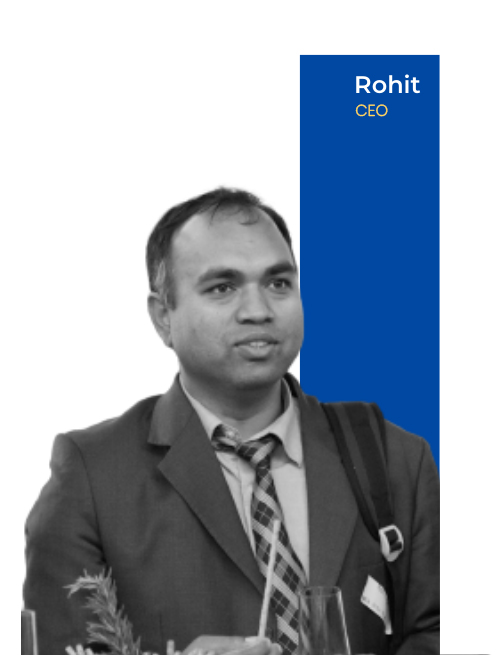Rohit Kumar is responsible for Researchwire European & North American business. He is an HEC, Paris 2008 MBA and Indian Institute of Technology (IIT) Kharagpur 2002 engineering graduate with close to 17 years of experience in business innovation and strategy, business development and client relationship roles. He is working with ResearchWire since 2016 and as a partner, is responsible for the growth of ResearchWire in Europe and North America.
Prior to ResearchWire, Rohit was handling sales strategy and pricing for Syniverse Technologies, a telecom services provider, where he was instrumental for growth in EMEA and India through product innovations, creative pricing and discounting models and executing strategic sales plans.
Rohit is based out of Luxembourg and has been living in Europe for last 12 years. He understands European & North American customers and their needs and ensures that our customers always have a local person to reach out whenever needed.
Introduction
In our ever-evolving tech world, wearable technology is stepping out of its traditional confines and finding unexpected applications in agriculture. With the world population booming, the need to supercharge how we grow crops is louder than ever. The advent of wearable plant sensors heralds a promising era, where the meticulous monitoring of individual crop water intake emerges as a transformative solution.
In anticipation of a 70% surge in global food production demand by 2050, the UN Food and Agriculture Organization underscores the need for agricultural innovation. While sensor-equipped tractors and satellite data have boosted efficiency, the next frontier is Wearable Plant Sensors. These compact devices, adorning crops, monitor temperature, humidity, moisture, and nutrients in real-time, promising optimized yields, reduced waste, disease detection, and ecological footprint minimization.
Challenges persist, but Wearable Plant Sensors have the potential to revolutionize crop management. Another innovative system, FBG-Based Botanical Wearables, introduces multiplexed sensors, offering an elegant solution for practical deployment in agriculture and environmental research. This transformative journey signifies a paradigm shift in plant monitoring, advancing agricultural and environmental practices.
Advent and Importance of Wearable Sensors for Plants
Wearable Plant Sensors are like superheroes for farmers, ushering in a new era of precision agriculture. They bring powerful tools, fuelled by data, to the farming world, giving farmers the knowledge, they need to work smarter. It’s a delicate dance we’re part of, where plants aren’t just crops but the very heart of our oxygen and food supply. Pivotal to this mission is the 2030 Agenda for Sustainable Development, which recognizes the role of technological innovation in advancing sustainable practices at the plant level.
Wearable plant sensors are like tiny data wizards continually amassing real-time data on crucial parameters such as temperature, humidity, soil moisture, light intensity, and nutrient concentrations, these diminutive devices provide farmers with an abundance of knowledge. This wealth of information becomes a powerful tool that enable farmers to comprehend their plants’ unique needs and tailor interventions with unparalleled precision.
As we dive deeper into the aspects of modern farming, we find that cutting-edge technology is reshaping the game, promising a profound impact on productivity. Issues like diseases and pests that are forever threatening our crops, are getting a pre-emptive smackdown. It’s like giving agriculture a superhero shield, defending our crops and securing our food supply.
Wearable sensors and plants work in great partnership with each other. They create an environment where problems are spotted and dealt with before they become headaches. The result? Better crops, both in terms of quality and quantity. Wearable sensors play a pivotal role since it is about securing the resources we need, making sure our global food supply is resilient, and taking care of our planet’s well-being. They’re not just gadgets; they’re guardians of a greener, healthier future.
Types of Wearable Sensors for Plants
Globally, the rising field of precision agriculture has witnessed a proliferation of diverse wearable sensors tailored specifically for plants, reflecting a dynamic fusion of technology and agriculture.
-
Soil Moisture Sensors
Soil moisture sensors play a pivotal role in precision agriculture by offering real-time insights into soil hydration levels. Functioning as key tools for optimizing irrigation practices, these sensors prevent over- or under-irrigation, conserving water resources and enhancing crop yield. Their integration into precision farming practices underscores their significance in sustainable and resource-efficient agricultural management.
-
Light Intensity Sensors
Essential in monitoring sunlight reaching crops, light intensity sensors contribute significantly to precision farming. By gauging sunlight levels and optimizing planting strategies based on light requirements for photosynthesis, these sensors ensure that crops receive the necessary solar energy for robust growth and improved yield. Their role in data-driven decision-making makes them integral components of modern agricultural practices.
-
Nutrient Sensors
In the realm of precision agriculture, nutrient sensors play a crucial role in assessing soil fertility by measuring essential nutrient levels. By providing accurate information on soil nutrition, these sensors enable farmers to tailor fertilization practices, ensuring optimal plant health and growth. The precision they bring to nutrient management is a key factor in sustainable and efficient agricultural production.
-
Stretchable Sensors
Representing a cutting-edge advancement in plant monitoring, stretchable sensors conform to the plant’s surface, measuring physical changes such as elongation and leaf expansion. These innovative sensors offer valuable insights into growth patterns and stress responses in plants, providing farmers with comprehensive data for better decision-making. Their contribution to understanding plant development marks a significant advancement in agricultural practices and research.
As precision agriculture continues to evolve, wearable sensors for plants are diversifying to encompass an array of parameters, providing farmers with comprehensive, real-time data to enhance decision-making and cultivate a more sustainable and productive agricultural landscape globally.
Companies working on Wearable Plant Sensors: New Developments
-
Liang Dong and Graphene-Based Sensors:
An associate professor of electrical and computer engineering at Iowa State University, who is leading the development of graphene-based sensors-on-tape. These sensors can be attached to plants, providing valuable data to researchers and farmers about water use in crops. The technology has broad applications, ranging from biomedical diagnostics and monitoring structural integrity to environmental monitoring. Liang Dong, the lead author and developer of the technology, collaborated with a team, including a doctoral student, Seval Oren, who helped develop the sensor-fabrication technology. The potential applications include disease or pesticide testing in crops, showcasing the versatility of the graphene-based sensor technology.
-
Monsanto (Now Part of Bayer) and Syngenta:
Major agricultural companies like Monsanto (now part of Bayer) and Syngenta have been involved in the development and implementation of advanced agricultural technologies. While specific cases may vary, these companies often engage in global collaborations and have a significant presence in the wearable plant sensor landscape.
These agricultural technology companies play pivotal roles in revolutionizing modern farming practices. Arable Labs specializes in delivering data-driven insights through a range of sensors, monitoring crop health, weather conditions, and soil moisture.
Semios, on the other hand, focuses on precision farming solutions with wireless networked sensors catering to pest monitoring, weather conditions, and various factors influencing crop health. Teralytic takes a deep dive into soil health, offering sensors equipped with multiple probes to measure parameters like nutrient levels and moisture content.
CropX excels in soil sensing technology, providing farmers with crucial insights into soil conditions, moisture levels, and optimal irrigation. METER Group contributes environmental monitoring solutions, including soil moisture sensors and weather stations. Libelium offers wireless sensor platforms, enabling farmers to monitor environmental parameters like soil moisture, temperature, and humidity.
OnFarm stands out with its integrated platform for agricultural data analytics, incorporating sensor data on soil conditions, weather, and crop health. Lastly, SeeTree employs AI and sensor technologies to offer comprehensive insights into orchard health, providing data on tree vitality, pest infestations, and other pertinent factors.
Together, these companies contribute to a data-driven agricultural landscape, empowering farmers with the knowledge needed for more informed decision-making and sustainable farming practices. Startups in the agricultural technology sector are also working on wearable plant sensors. These companies often face legal challenges, strategic decisions regarding intellectual property, and may contribute to the evolving patent landscape.
How Researchwire Adds Value
Beyond market trend analyses, Researchwire distinguishes itself by offering patent intelligence that transcends mere documentation. Harnessing advanced algorithms, the platform analyzes patent data, providing strategic insights into the strengths, weaknesses, opportunities, and threats posed by competitors. This patent intelligence becomes a cornerstone for companies, enabling them to devise robust strategies for safeguarding innovations, navigating legal landscapes, and making informed decisions conducive to sustainable growth.
Utilizing advanced analytical tools, the platform sifts through vast data sets to discern patterns, identify emerging technologies, and recognize shifts in market dynamics. This capability enables companies to cultivate a nuanced understanding of the intellectual property landscape, staying ahead of industry trends and making informed decisions.
Conclusion
The evolution of Wearable Plant Sensors emerges as a transformative force, promising a new era of precision farming. The impending surge in global food production demand by 2050 underscores the urgency for agricultural innovation, and Wearable Plant Sensors present a promising solution for optimized yields, reduced waste, and ecological sustainability.
As we explore the types of wearable sensors for plants, including soil moisture, light intensity, and nutrient sensors, it becomes evident that these innovations are shaping a data-driven agricultural landscape. The inclusion of companies such as Arable Labs, Semios, Teralytic, CropX, METER Group, Libelium, OnFarm, and SeeTree highlights the collaborative efforts of industry leaders and startups in revolutionizing farming practices through sensor technologies.
If you are a stakeholder in the innovation ecosystem and are looking to get insights into trends in specific technology areas to better position yourself in making proper business decisions, or are developing, or planning to develop, a strong patent portfolio around specific technologies and its use cases, reach out to Researchwire.
About Us
Researchwire is an ISO 27001 certified, specialised IP research and R&D support company. Works closely with IP & legal teams to provide patent portfolio services and all types of patent searches & patent drafting. It provides enterprises and R&D centres with insightful and effective solutions to address their technology development challenges and roadmap planning.




